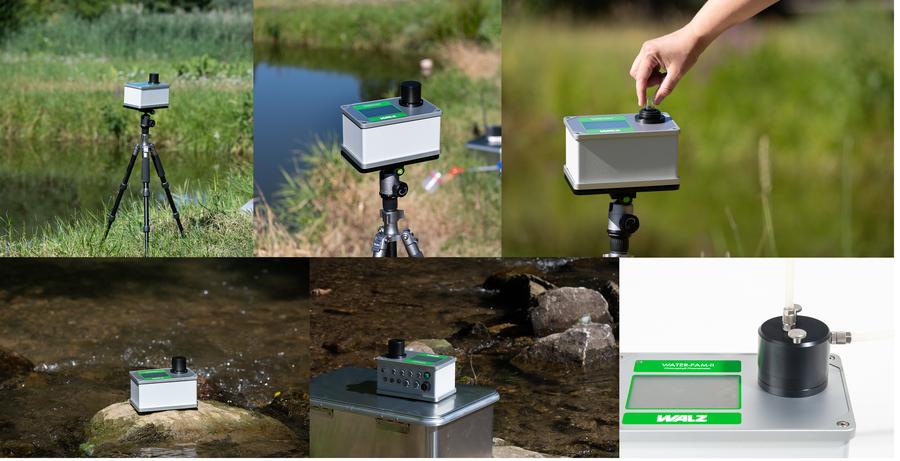主要功能
可测荧光诱导曲线(IC)并进行淬灭分析
可测光响应曲线(LC)和快速光曲线(RLC)
基于不同藻类在450nm,520nm,630nm,660nm的荧光激发光谱差异来计算和分析自然水体藻类成分(蓝藻,绿藻,硅/甲藻),
测量蓝藻,绿藻,硅/甲藻的叶绿素a浓度和计算总叶绿素a(Total Chla)浓度。
可测量水样的下列光合指标活性:
光合效率和光合速率(相对电子传递速率)
藻类的潜在ZD光合效率(“生长潜能”)
有害藻华(HABs)研究的理想工具
藻类的光保护能力
藻类耐受强光的能力
顶层菜单方便快速启动常规测量,直观显示曲线动态进程
测量参数
Fo, Fm, Fv/Fm, F, Fm’, Fo’, Y(II)=ΔF/Fm’, qP, qN, NPQ, Y(NPQ), Y(NO), ETR, α,Ik,ETRmax
蓝藻,绿藻,硅甲藻叶绿素a浓度和总叶绿素a浓度等
应用领域
测量野外自然水样或实验室培养的微藻样品的光合作用,标准版是一台超便携的设备,在标准版的基础上加配流通版样品室和蠕动泵套件即可实现连续监测。
WATER-PAM-II还搭载与了PHYTO-PAM-II类似的荧光激发光谱,基于不同藻类在450nm,520nm,630nm,660nm的荧光激发光谱差异来计算和分析自然水体藻类成分(蓝藻,绿藻,硅甲藻),分别测量每个藻中类的叶绿素a浓度和计算总叶绿素a(Total Chla)浓度。
可应用于水生生物学、水域生态学、海洋学、湖沼学等领域,检测限达0.1 μgChl/L。可用于有害藻华(HABs)的早期预警。
主要技术参数
测量光源:蓝光LED,450nm和红光LED,630nm; 520和660 nm LED辅助蓝藻、绿藻、硅/钾藻分类
光化光源:蓝色LED,450nm和红光LED,630 nm
饱和脉冲光源:蓝色LED,450nm和红光LED,630 nm
远红光:远红光LED,发射峰730 nm
数据存储:27000组饱和脉冲数据
供电:8节AA可充电电池,续航可达30小时,可满足70000次Yield测量,8节备用电池

产地:德国 WALZ
参考文献
WATER-PAM-II近期刚推出,以下列表为WATER-PAM文献
数据来源:光合作用文献 Endnote 数据库,更新至 2021年 5月,数据库总文献数量超过 10000 篇
原始数据来源:Google Scholar
Chen, R.-S., et al. (2021). "Effects of Mn2+ on neutral lipid content, C4 pathway, and related gene expression in Phaeodactylum tricornutum." Journal of Applied Phycology.
Alekseev, A. A., et al. (2021). "Influence of mercury salts on the condition of algae as studied by fluorescence methods." 9th International Conference on Mathematical Modeling 2328(1): 050001.
Baho, D. L., et al. (2021). "Ecological Memory of Historical Contamination Influences the Response of Phytoplankton Communities." Ecosystems.
Bhagooli, R., et al. (2021). "Chlorophyll fluorescence – A tool to assess photosynthetic performance and stress photophysiology in symbiotic marine invertebrates and seaplants." Marine pollution bulletin 165: 112059.
Castro-Varela, P. A., et al. (2021). "Photobiological Effects on Biochemical Composition in Porphyridium cruentum (Rhodophyta) with a Biotechnological Application." n/a(n/a).
Gu, Z., et al. (2021). "Enhancement of nutrients removal and biomass accumulation of Chlorella vulgaris in pig manure anaerobic digestate effluent by the pretreatment of indigenous bacteria." Bioresource Technology 328: 124846.
Li, S., et al. (2021). "Exploring the potential of photosynthetic induction factor for the commercial production of fucoxanthin in Phaeodactylum tricornutum." Bioprocess and biosystems engineering.
Puig-Fàbregas, J., et al. (2021). "Evaluation of actin as a reference for quantitative gene expression studies in Emiliania huxleyi (Prymnesiophyceae) under ocean acidification conditions." Phycologia: 1-10.
Soleymani Robati, S. M., et al. (2021). "Increase in lipid productivity and photosynthetic activities during distillery wastewater decolorization by Chlorella vulgaris cultures." Applied Microbiology and Biotechnology.
Song, Y., et al. (2021). "Electrokinetic detection and separation of living algae in a microfluidic chip: implication for ship’s ballast water analysis." Environmental Science and Pollution Research.
Xi, Y., et al. (2021). "Photosynthetic profiling of a Dunaliella salina mutant DS240G-1 with improved β-carotene productivity induced by heavy ions irradiation2021." International Journal of Agricultural and Biological Engineering.
Xu, K., et al. (2021). "Toxic and protective mechanisms of cyanobacterium Synechocystis sp. in response to titanium dioxide nanoparticles." Environmental Pollution: 116508.
Zhao, L., et al. (2021). "Light modulates the effect of antibiotic norfloxacin on photosynthetic processes of Microcystis aeruginosa." Aquatic Toxicology 235: 105826.
Zhu, J., et al. (2021). "Bacteriophage therapy on the conchocelis of Pyropia haitanensis (Rhodophyta) infected by Vibrio mediterranei 117-T6." Aquaculture 531: 735853.
上海泽泉科技股份有限公司
仪器网(yiqi.com)--仪器行业网络宣传传媒